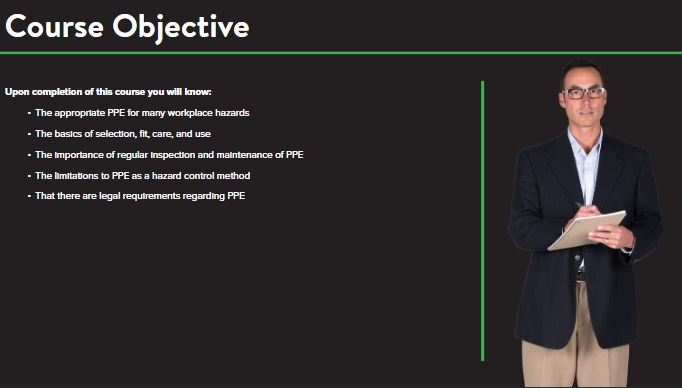By the end of this lesson employees will know types of respiratory hazards and possible health effects, ways to minimize or eliminate hazards, qualifications for respirator use, types of respirators, selecting the right one, and proper respirator care.
Basic Respiratory Protection
$24.15
Description
Learning Objectives
- Identify the purpose of using a respirator
- Recognize factors that influence respirator effectiveness, the limitations and capabilities of respirators, and an employer’s responsibilities for respirator use in the workplace
- Describe how respirators are used in the workplace, including required medical evaluations, fit testing, inspection, seal checks, and maintenance and storage requirements
- Identify when an employee should leave a respirator use area, the warning signs of an improperly functioning respirator, and the actions workers should take in an emergency situation
Respiratory equipment prevents around 4,000 illnesses and 900 deaths each year.LABOR STATISTICS, OSHA
The quality of the air we breathe, both on and off the job, has major implications for our respiratory health. That’s why some regions in the United States alert local citizens when smog or air pollution reaches an unsafe level.
Certain industrial work environments threaten respiratory health; people who work in construction, manufacturing, agriculture, and other industries will be inevitably exposed to respiratory hazards on the job. By performing tasks where irritating dust, chemical fumes, and other airborne contaminants are present in harmful concentrations, or where the percentage of oxygen is insufficient, these workers have to be mindful of the air they are breathing.
That is why the Occupational Safety and Health Administration (OSHA) requires employers to take the necessary precautions to control for respiratory hazards at worksites. The major rule is that if an employer cannot eliminate respiratory hazards, the employer must provide employees with respirators to protect their health. So from job to job, there’s much to discuss about personal protective equipment and systems for safeguarding respiratory help.
The purpose of OSHA’s respiratory protection standards is to try to prevent tragic workplace accidents and latent illnesses caused by exposure to respiratory hazards that workers may encounter on the job. The category of airborne contaminants is vast, and there are numerous safety considerations. If you work in an environment that poses some respiratory risks, you’re likely aware of steps for minimizing your risk of exposure, and familiar with some respiratory devices. But because of unpredictability there is a lot to learn about protection from airborne contaminants, and it is important to know in what forms these hazards exist, where you’re likely to find them, and how they physically behave. If you understand the properties of airborne contaminants, you can better apply appropriate measures to control them, avoid exposure, and treat symptoms.
Generally, and depending on myriad factors, the effect on the body from inhaling a contaminant may be immediate or may not show up for many years, and symptoms can range from mild and temporary to severe, with permanent injury or even death.
Chronic exposure to respiratory hazards may create an illness that develops over many months or years. This type of respiratory injury usually results from repeated exposure to low concentrations of a contaminant without the use of a respirator. In other cases of illness, the effect of a respiratory hazard may be acute, meaning the effect occurs immediately or very soon after exposure to a high concentration of a contaminant.
How does OSHA classify and regulate for airborne contaminates? OSHA defines an atmosphere that poses an extreme threat to workers as an atmosphere “immediately dangerous to life and health” (IDLH). An atmosphere is labeled IDLH when exposure to it would pose an immediate threat to life, would cause irreversible adverse health effects, or would interfere with an individual’s ability to escape from the dangerous atmosphere.
The normal air we breathe has an oxygen concentration of 20.9%. An atmosphere is IDLH if the oxygen concentration is below 14%. However, even if atmospheric oxygen concentration is normal, the atmosphere may still be IDLH if the concentration of a toxic substance exceeds the IDLH exposure limit for that substance.
OSHA requires any employer whose workers wear respirators on the job to have a written respiratory protection program. The standard program must cover respirator selection, worksite-specific usage procedures, fit testing, training, cleaning and maintenance, and medical screenings. Employers must also evaluate the effectiveness of the company’s respiratory protection program regularly and must modify the program based on the evaluation results.
Not all training is equal. With SafetyNow, learners and leaders will notice the difference in value:
- Quality: Professionally-researched and designed using the latest mobile and responsive technologies
- Convenience: Works instantly on any device, desktop or mobile
- Time savings: What learners need to know, not extra fluff or legalese
- Reporting: Consistent, instant compliance records available anytime
- Support: Customer and learner support included at no charge
- Any Learning Management System (LMS) Use with any SCORM, AICC, xAPI, TinCan, HTML5, or other LMS (learning management system).
- Any Device Desktop, laptop, tablet, or mobile phone – it simply works, everywhere.
- Engaging Professionally-developed, including an on-screen host and modern, easy-to-understand text, media, and voiceovers.
- Unlimited Attempts Each module can be taken as many times as required to get a passing grade. Unlike our competitor’s courses, if you get an answer wrong, you are redirected to the exact eLearning segment you struggled with… you don’t need to go through the entire module again, just the one part you need a refresher on.
Only logged in customers who have purchased this product may leave a review.













Reviews
There are no reviews yet.